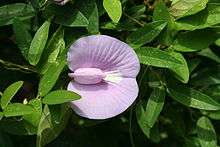Centrosema virginianum
| Centrosema virginianum | |
|---|---|
 | |
| Scientific classification | |
| Kingdom: | Plantae |
| (unranked): | Angiosperms |
| (unranked): | Eudicots |
| (unranked): | Rosids |
| Order: | Fabales |
| Family: | Fabaceae |
| Genus: | Centrosema |
| Species: | C. virginianum |
| Binomial name | |
| Centrosema virginianum (L.) Benth. | |
Centrosema virginianum has different common names such as Virginian centro, wild blue vine, blue bell, and wild pea.[1] C. virginianum is a member of the Fabaceae family, it is identify by its trailing and twining vine.[2] The stems are tender and small in proportion to its height. C. virginianum habitats are in pine lands and coastal uplands.[2]
Morphology
Centrosema virginianum are perennial and herbaceous vine [3] a couple meters in length; stems are approximately 29 to 160 centimeters long.[1] It has three alternate pinnately leaves, 3 to 10 centimeters long. C. virginianum leaves are lanceolate or ovate, 1 to 4 mm long,[1] and the petiole are identify to be 2 to 5 cm long. Stipules are often deciduous, and mostly setaceous.[1] There is a wide range of leaflets from linear to ovate to oblong or lanceolate-oblong, acute or acuminate at the apex.[1] C. virginianum produces abundant flowers, between early August and late September [3]
Distribution
C. virginianum are present more or less constant from Uruguay and northern Argentina to the eastern United States to the eastern United States and Bermuda in tropical and subtropical areas.[1][2] Lastly, it is wide distributed throughout West Indies and has become naturalized in tropical West Africa.[1]
Flowers
Flowers of Centrosema virginianum, are highly specialized in an inverted (resupinate) flag adapted by pollinators.[3] A group of flowers of one to four flowers on axillary penducle, calyx deeply five-lobed, and the acute lobes longer than the tube.[1] The corolla purplish or lavender-blue close to white,[1] it contains four to ten dark or brown seeds.[1] The diversity of leaflets and corolla size, color and shape often are confused with C. pubescens.[1] Lastly, C. virginianum flowers are known to be hermaphrodite and are pollinated by bees, additionally they contribute to nitrogen fixing.[4]
See also
References
- 1 2 3 4 5 6 7 8 9 10 11 "CentrosemaVirginianum". Retrieved 18 April 2012.
- 1 2 3 "IRC-Natives for your Neighborhood". Retrieved 18 April 2012.
- 1 2 3 "Island and Mainland Pollination Ecology of Centrosema Virginianum and Opuntia Stricta". JSTOR 2260423.
- ↑ Benth., L. "Plants for the future". Retrieved 18 April 2012.